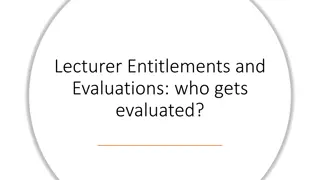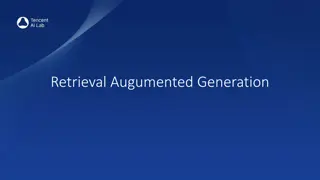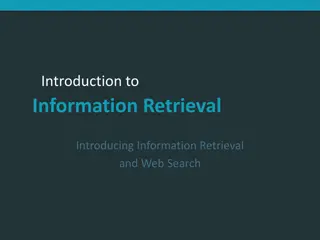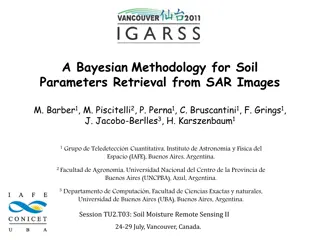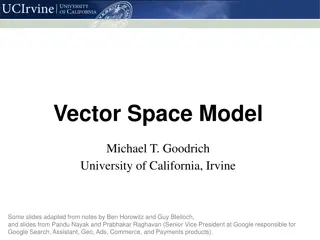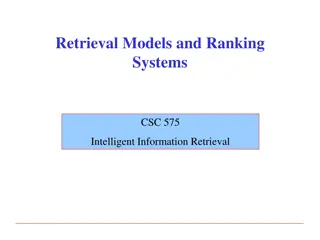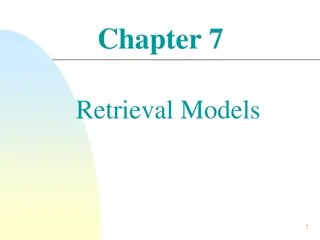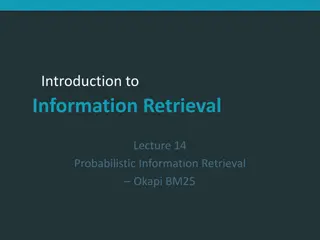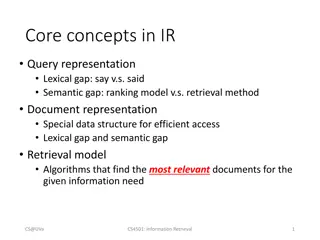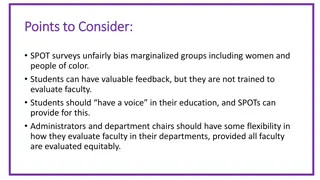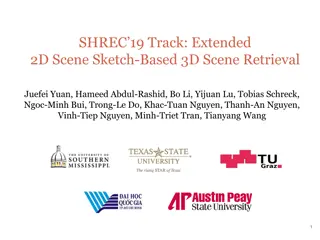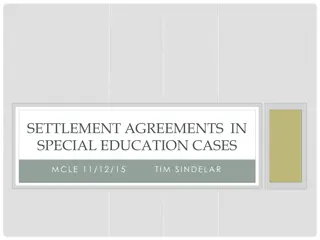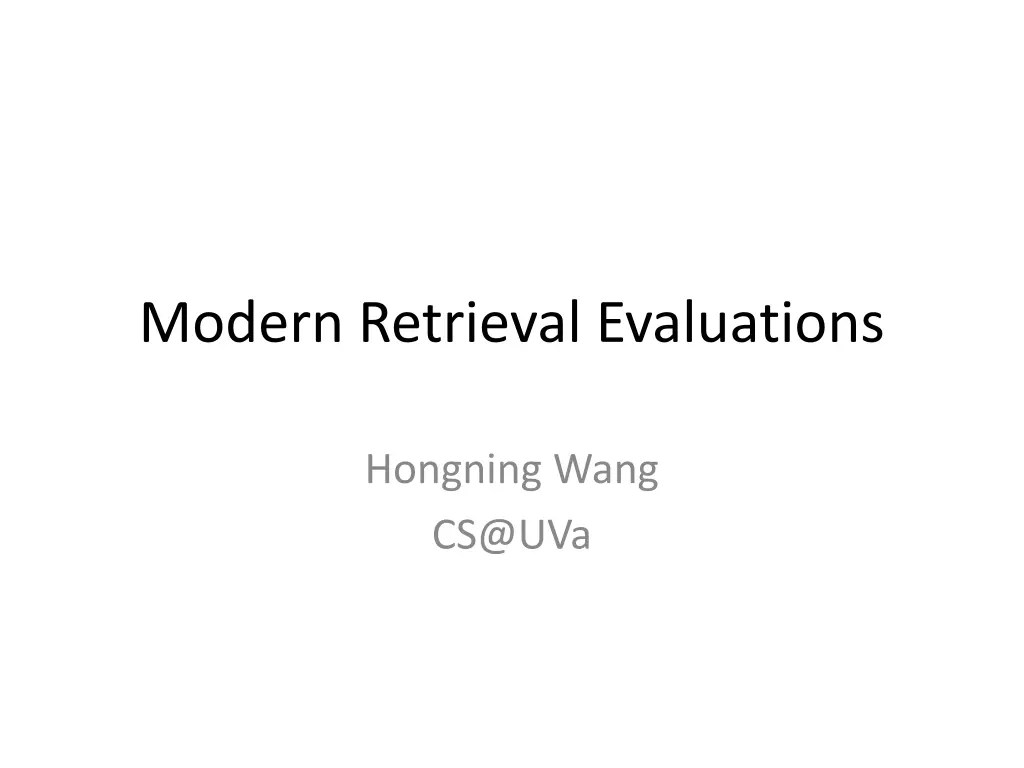
Understanding Information Retrieval Evaluations
Explore the key elements of information retrieval evaluations, the goal of IR systems, and the alignment between user preferences and evaluation measures. Discover how experimental settings and results shed light on the effectiveness of different IR systems.
Download Presentation

Please find below an Image/Link to download the presentation.
The content on the website is provided AS IS for your information and personal use only. It may not be sold, licensed, or shared on other websites without obtaining consent from the author. If you encounter any issues during the download, it is possible that the publisher has removed the file from their server.
You are allowed to download the files provided on this website for personal or commercial use, subject to the condition that they are used lawfully. All files are the property of their respective owners.
The content on the website is provided AS IS for your information and personal use only. It may not be sold, licensed, or shared on other websites without obtaining consent from the author.
E N D
Presentation Transcript
Modern Retrieval Evaluations Hongning Wang CS@UVa
What we have known about IR evaluations Three key elements for IR evaluation A document collection A test suite of information needs A set of relevance judgments Evaluation of unranked retrieval sets Precision/Recall Evaluation of ranked retrieval sets P@k, MAP, MRR, NDCG Statistic significance Avoid randomness in evaluation CS@UVa CS 4780: Information Retrieval 2
Rethink retrieval evaluation Goal of any IR system Satisfying users information need Core quality measure criterion how well a system meets the information needs of its users. wiki Are traditional IR evaluations qualified for this purpose? What is missing? CS@UVa CS 4780: Information Retrieval 3
Do user preferences and evaluation measures line up? [Sanderson et al. SIGIR 10] Research question 1. Does effectiveness measured on a test collection predict user preferences for one IR system over another? 2. If such predictive power exists, does the strength of prediction vary across different search tasks and topic types? 3. If present, does the predictive power vary when different effectiveness measures are employed? 4. When choosing one system over another, what are the reasons given by users for their choice? CS@UVa CS 4780: Information Retrieval 4
Experiment settings User population Crowd sourcing Mechanical Turk 296 ordinary users Test collection TREC 09 Web track 50 million documents from ClueWeb09 30 topics Each included several sub-topics Binary relevance judgment against the sub-topics CS@UVa CS 4780: Information Retrieval 5
Experiment settings IR systems 19 runs of submissions to the TREC evaluation Users need to make side-by-side comparison to give their preferences over the ranking results CS 4780: Information Retrieval CS@UVa 6
Experimental results User preferences v.s., retrieval metrics Metrics generally match users preferences, no significant differences between metrics CS@UVa CS 4780: Information Retrieval 7
Experimental results Zoom into nDCG Separate the comparison into groups of small differences and large differences Compare to mean difference Users tend to agree more when the difference between the ranking results is large CS@UVa CS 4780: Information Retrieval 8
Experimental results What if when one system did not retrieve anything relevant All metrics tell the same and mostly align with the users CS@UVa CS 4780: Information Retrieval 9
Experimental results What if when both systems retrieved something relevant at top positions P@10 cannot distinguish the difference between systems CS@UVa CS 4780: Information Retrieval 10
Conclusions of this study IR evaluation metrics measured on a test collection predicted user preferences for one IR system over another The correlation is strong when the performance difference is large Effectiveness of different metrics vary CS@UVa CS 4780: Information Retrieval 11
How does clickthrough data reflect retrieval quality [Radlinski CIKM 08] User behavior oriented retrieval evaluation Low cost Large scale Natural usage context and utility Common practice in modern search engine systems A/B test CS@UVa CS 4780: Information Retrieval 12
A/B test Two-sample hypothesis testing Two versions (A and B) are compared, which are identical except for one variation that might affect a user's behavior E.g., indexing with or without stemming Randomized experiment Separate the population into equal size groups 10% random users for system A and 10% random users for system B Null hypothesis: no difference between system A and B Z-test, t-test CS@UVa CS 4780: Information Retrieval 13
Behavior-based metrics Abandonment Rate Fraction of queries for which no results were clicked on Reformulation Rate Fraction of queries that were followed by another query during the same session Queries per Session Mean number of queries issued by a user during a session CS@UVa CS 4780: Information Retrieval 14
Behavior-based metrics Clicks per Query Mean number of results that are clicked for each query Max Reciprocal Rank Max value of 1/?, where r is the rank of the highest ranked result clicked on Mean Reciprocal Rank Mean value of ?1/??, summing over the ranks ?? of all clicks for each query Time to First Click Mean time from query being issued until first click on any result Time to Last Click Mean time from query being issued until last click on any result CS@UVa CS 4780: Information Retrieval 15
Behavior-based metrics When search results become worse: CS@UVa CS 4780: Information Retrieval 16
Experiment setup Philosophy Given systems with known relative ranking performance Test which metric can recognize such difference Reverse thinking of hypothesis testing In hypothesis testing, we choose system by test statistics In this study, we choose test statistics by systems CS@UVa CS 4780: Information Retrieval 17
Constructing comparison systems Orig > Flat > Rand Orig: original ranking algorithm from arXiv.org Flat: remove structure features (known to be important) in original ranking algorithm Rand: random shuffle of Flat s results Orig > Swap2 > Swap4 Swap2: randomly selects two documents from top 5 and swaps them with two random documents from rank 6 through 10 (the same for next page) Swap4: similar to Swap2, but select four documents for swap CS@UVa CS 4780: Information Retrieval 18
Result for A/B test 1/6 users of arXiv.org are routed to each of the testing systems in one month period CS@UVa CS 4780: Information Retrieval 19
Result for A/B test 1/6 users of arXiv.org are routed to each of the testing systems in one month period CS@UVa CS 4780: Information Retrieval 20
Result for A/B test Few of such comparisons are significant CS@UVa CS 4780: Information Retrieval 21
Interleave test Design principle from sensory analysis Instead of asking for absolute ratings, ask for relative comparison between alternatives E.g., is A better than B? Randomized experiment Interleave results from both A and B Giving interleaved results to the same population and ask for their preference Hypothesis test over preference votes CS@UVa CS 4780: Information Retrieval 22
Coke v.s. Pepsi Market research Do customers prefer coke over pepsi, or they do not have any preference Option 1: A/B Testing Randomly find two groups of customers and give coke to one group and pepsi to another, and ask them if they like the given beverage Option 2: Interleaved test Randomly find a group of users and give them both coke and pepsi, and ask them which one they prefer CS@UVa CS 4780: Information Retrieval 23
Interleave for IR evaluation Team-draft interleaving CS@UVa CS 4780: Information Retrieval 24
Interleave for IR evaluation Team-draft interleaving 2 1 3 2 1 5 4 3 5 6 7 8 8 7 6 4 Ranking A: Ranking B: 1 1 RND = 0 Interleaved ranking 4 2 3 1 5 6 CS@UVa CS 4780: Information Retrieval 25
Result for interleaved test 1/6 users of arXiv.org are routed to each of the testing systems in a one month period Test which group receives more clicks CS@UVa CS 4780: Information Retrieval 26
Conclusion Interleaved test is more accurate and sensitive 9 out of 12 experiments follow our expectation Only click count is utilized in this interleaved test More aspects can be evaluated E.g., dwell-time, reciprocal rank, if leads to download, is last click, is first click Interleave more than two systems for comparison CS@UVa CS 4780: Information Retrieval 27
Welcome back We will start our discussion at 2pm sli.do event code: 654588 MP2 will be official from tonight Please start thinking about our literature survey task for graduate students CS@UVa CS4780: Information Retrieval 28
Recap: do user preferences and evaluation measures line up? [Sanderson et al. SIGIR 10] IR evaluation metrics measured on a test collection predicted user preferences for one IR system over another The correlation is strong when the performance difference is large Effectiveness of different metrics vary CS@UVa CS 4780: Information Retrieval 29
Recap: how does clickthrough data reflect retrieval quality [Radlinski CIKM 08] Interleaved test is more accurate and sensitive 9 out of 12 experiments follow our expectation Only click count is utilized in this interleaved test More aspects can be evaluated E.g., dwell-time, reciprocal rank, if leads to download, is last click, is first click Interleave more than two systems for comparison CS@UVa CS 4780: Information Retrieval 30
Comparing the sensitivity of information retrieval metrics [Radlinski & Craswell, SIGIR 10] How sensitive are those IR evaluation metrics? How many queries do we need to get a confident comparison result? How quickly can it recognize the difference between different IR systems? CS@UVa CS 4780: Information Retrieval 31
Experiment setup IR systems with known search effectiveness Large set of annotated corpus 12k queries Each retrieved document is labeled into 5-grade level Large collection of real users clicks from a major commercial search engine Approach Gradually increase evaluation query size to investigate the conclusion of metrics CS@UVa CS 4780: Information Retrieval 32
Sensitivity of NDCG@5 System effectiveness: A>B>C CS@UVa CS 4780: Information Retrieval 33
Sensitivity of P@5 System effectiveness: A>B>C CS@UVa CS 4780: Information Retrieval 34
Sensitivity of interleaving CS@UVa CS 4780: Information Retrieval 35
Correlation between IR metrics and interleaving CS@UVa CS 4780: Information Retrieval 36
How to assess search result quality? Query-level relevance evaluation Metrics: MAP, NDCG, MRR, CTR Task-level satisfaction evaluation Users satisfaction of the whole search task Goal: find existing work for action-level search satisfaction prediction START Q1 Q2 Q3 Q4 Q5 END D21 D31 D51 D24 D54 CS@UVa CS 4780: Information Retrieval 37
Example of search task Information need: find out what metal can float on water Search Actions Engine Time Q: metals float on water Google 10s SR: wiki.answers.com 2s quick back BR: blog.sciseek.com 3s Q: which metals float on water Google 31s query reformulation Q: metals floating on water Google 16s SR: www.blurtit.com 5s Q: metals floating on water Bing 53s search engine switch Q: lithium sodium potassium float on water Google 38s SR: www.docbrown.info 15s CS@UVa CS 4780: Information Retrieval 38
Beyond DCG: User Behavior as a Predictor of a Successful Search [Ahmed et al. WSDM 10] Modeling users sequential search behaviors with Markov models A model for successful search patterns A model for unsuccessful search patterns ML for parameter estimation on annotated data set CS@UVa CS 4780: Information Retrieval 39
Predict user satisfaction Choose the model that better explains users search behavior ? ? ? = 1 ? ?=1 ? ? = 1 ? = ? ? ? = 1 ? ?=1 +? ? ? = 0 ? ?=0 Likelihood: how well the model explains users behavior Prior: difficulty of this task, or users expertise of search Prediction performance for search task satisfaction CS@UVa CS 4780: Information Retrieval 40
What you should know IR evaluation metrics generally align with users result preferences A/B test v.s. interleaved test Sensitivity of evaluation metrics Direct evaluation of search satisfaction CS@UVa CS 4780: Information Retrieval 41


